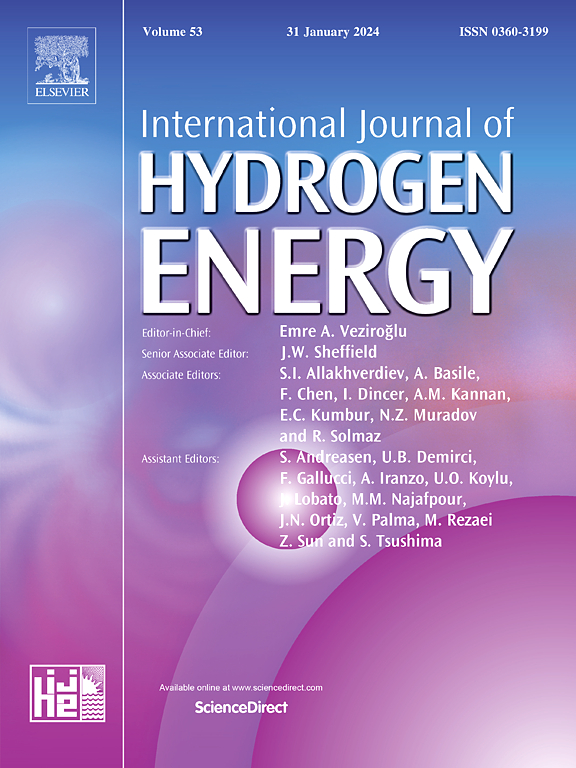基于数值模型、人工神经网络和遗传算法的大型质子交换膜燃料电池收敛-发散流场优化
IF 8.3
2区 工程技术
Q1 CHEMISTRY, PHYSICAL
引用次数: 0
摘要
设计良好的流场对于大规模商用质子交换膜燃料电池(PEMFC)的性能和耐久性至关重要。在传统的流场设计与优化研究中,小规模PEMFC只采用了少数结构,忽略了活性面积增加带来的影响,限制了新型流场的应用。本研究提出了一种新型的收敛发散(C-D)通道,并基于多目标优化(MOO)方法,包括数值模型、人工神经网络(ANN)和非支配排序遗传算法(NSGA-Ⅱ)。结果表明,优化后的C-D通道通过促进液滴加速和强迫氧的运输,在考虑寄生损失的情况下,提高了水管理能力和净输出功率密度。此外,还介绍并分析了除水时间(t),这是一个关键的评价指标,但在以往的MOO研究中往往被忽略。在各指标上,结构优化后的C-D通道均优于基准情况,表明流场优化成功。本研究有望为未来基于数值模型和人工智能的大规模商用PEMFC流场设计与优化提供创新指导。本文章由计算机程序翻译,如有差异,请以英文原文为准。
Optimization of convergent-divergent flow field for large-scale proton exchange membrane fuel cells based on the numerical model, artificial neural network and genetic algorithm
A well-designed flow field is critical for the performance and durability of large-scale commercial proton exchange membrane fuel cell (PEMFC). In the conventional flow field design and optimization studies, only a few structures are utilized in small-scale PEMFC and the effects caused by the increase of active area are ignored which limit the application of novel flow fields. In this study, the novel converging-diverging (C-D) channel is proposed and optimized based on the multi-objective optimization (MOO) method including numerical model, artificial neural network (ANN) and nondominated sorting genetic algorithm (NSGA-Ⅱ). The results show that the optimized C-D channel can improve water management capacity and net output power density although accounting for the parasitic loss, by facilitating the acceleration of the droplet and forcing the transport of oxygen. The water removal time (t) is additionally introduced and analyzed, which is a key evaluation criterion but always ignored in previous MOO studies. In terms of all criteria, the C-D channel with optimized structure performs better than base case, indicating the success of flow field optimization. This study is expected to provide innovative guidance for design and optimization of future large-scale commercial PEMFC flow field based on numerical model and artificial intelligence.
求助全文
通过发布文献求助,成功后即可免费获取论文全文。
去求助
来源期刊

International Journal of Hydrogen Energy
工程技术-环境科学
CiteScore
13.50
自引率
25.00%
发文量
3502
审稿时长
60 days
期刊介绍:
The objective of the International Journal of Hydrogen Energy is to facilitate the exchange of new ideas, technological advancements, and research findings in the field of Hydrogen Energy among scientists and engineers worldwide. This journal showcases original research, both analytical and experimental, covering various aspects of Hydrogen Energy. These include production, storage, transmission, utilization, enabling technologies, environmental impact, economic considerations, and global perspectives on hydrogen and its carriers such as NH3, CH4, alcohols, etc.
The utilization aspect encompasses various methods such as thermochemical (combustion), photochemical, electrochemical (fuel cells), and nuclear conversion of hydrogen, hydrogen isotopes, and hydrogen carriers into thermal, mechanical, and electrical energies. The applications of these energies can be found in transportation (including aerospace), industrial, commercial, and residential sectors.
 求助内容:
求助内容: 应助结果提醒方式:
应助结果提醒方式:


